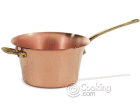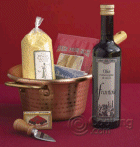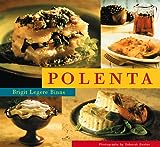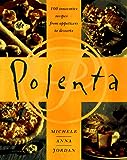Polenta, as we know it today, wouldn't have been possible without the discovery of America. Corn, an American novelty like tomatoes, was first grown in Spain as animal feed. But by the 17th century corn made it's way through very specific regions of Spain, France and, eventually, Northern Italy -- it was too dry to grow corn in central and southern Italy. Specifically, corn took root in the Veneto and Friuli regions where it was introduced by Venitian traders. It was quickly integrated into their cooking and almost replaced the use of rice and pasta in their regional specialties. In fact, Polenta is considered by the inhabitants of Veneto to be a proper bread.
In Trento and the northern regions of Lombardy, you can still l find the Paiolo, cauldron made of copper to prepare large quantities of polenta and risotto, in use over stovetop and chimney fires. The contents of this rustic pan are stirred with an equally medieval wooden club. A relatively large pasta pot and wooden spoon are adequate replacements in today's modern kitchen.
Polenta can be served soft, hard, grilled or fried. It can be topped with a myriad of sauces or have various ingredients folded in while it's still soft. Don't let the basic polenta recipe scare you, instant polenta logs are readily available in supermarkets in both the United States and Italy! Look for polenta or corn meal packages in your super market.
Pour 3 cups of the water into a heavy saucepan, add the salt and bring to a full rolling boil over high heat.
While the water is coming to a boil, stir the remaining 1/2 cup water into the cornmeal. Stir until the cornmeal is evenly dampened. This will keep the cornmeal from becoming lumpy as it cooks. As soon as the water boils, stir in the dampened cornmeal. Briskly whisk until the mixture is smooth.
Reduce the heat to medium-low and briskly stir the cornmeal for 2 or 3 minutes. The mixture will get stiff quickly. When the polenta begins to come away from the sides of the pan and the whisk stands up by itself in the center of the polenta, it is ready to serve.
Soft polenta can also become firm right before your guest's eyes. It can be presented theatrically by pouring soft polenta directly on top of a clean marble table-top (do not attempt this if you have polish or oil on your table-top) or on a large wooden cutting board.
Polenta e Zola - Polenta with Gorgonzola
This is the Milanese term for Polenta topped with melting (not melted) Gorgonzola. This is very filling and can be eaten as a whole meal with the addition of a green salad.
Flavor the polenta with chicken broth. Gorgonzola forte - strongly flavored Gorgonzola. (Gorgonzola tends to lose flavor when heated so it is best to use a strong one.)
When the polenta is cooked, spoon it into pasta dishes. Put a fairly large chunk of Gorgonzola in the middle of the polenta. Turn the oven on to broil and cook for a 3 - 5 minutes or until the Gorgonzola has melted partially. You don't want a sauce, you want a melting mound. Remove the dishes from the oven and serve immediately.
Laura's Twist: Place fresh sage leaves on the polenta right before adding the gorgonzola cheese. The cheese will "fry" the leaves and the sage will give the polenta an extra dimension of flavor.
Polenta Concia - Polenta with Butter and Fontina and Polenta Taragna (Milano)
4tbs fresh butter
13 oz. Fontina cheese
Prepare the basic recipe (above). While the polenta is cooking, dice the cheese in small pieces. After the polenta has cooked for half an hour, add the butter, cut in small pieces. Five minutes before turning the heat off, blend in the cheese. Let sit several minutes, turn it on a wooden board, cut with a wooden knife and serve.
Polenta con Funghi - Polenta with Mushrooms
Re-heat firm polenta in the oven for 15 minutes at 450 degrees. In the meantime, saut� mushrooms with garlic, parsley and white wine. Pour the mushrooms over crispy polenta squares.
Polenta con Salsa di Pepperoni rossi -Polenta with Red Pepper Sauce
Grind a clove of garlic in a food processor. Add 1 cup roasted bell pepper strips (jarred OK), 1/2 cup loosely packed Italian parsley leaves, 1/2 teaspoon paprika, pinch red pepper flakes, and 1 tablespoon each olive oil, wine vinegar and tomato paste. Blend until pureed.
Top broiled or fried polenta triangles (see firm polenta instructions, above) with thin slices of fontina or Monterey Jack cheese and broil. If desired, broil prawns to go alongside. Serve with the red pepper sauce.
Polenta con salsa di pomodoro alla Laura- Laura's Tomato Sauce Polenta
I use the same recipe that I use for making basic pasta-sauce, with the addition of sausage for a quick, complete meal. I especially enjoy making this dish during the winter as the polenta and sauce warms you both inside and out -- the fresh herbs and oil that are sprinkled on top at the end add a fresh zing.
1 Medium Onion, chopped
2 tbsp of Olive Oil
1 Itlaian sausage
12 oz. can of diced or crushed tomatoes
1 bunch of fresh basil or oregano (if you use dried herbs, use freshly chopped parsley for the last step of this dish)
2 pinches of red pepper flakes
salt and pepper to taste
Make the basic polenta, following the basic recipe (above) and pour into individual oven-safe bowls. Put the bowls of polenta in a warmed oven at 300 degrees. While the oven keeps the polenta warm, you can work on the sauce.
Heat a skillet with olive oil while you are chopping the onion and sausage. Toss in the chopped onions and sausage and stir occasionally to ensure even cooking. When the onions become translucent, pour in the diced tomatoes, and add 3/4's of the chopped basil/oregano and the pinches of red pepper flakes. Lower the temperature and let the sauce simmer for about 10 minutes.
Then, take the polenta bowls our of the oven and ladle the sauce on top, sprinkle with the remaining fresh herbs, and put a "squiggle" of extra virgin olive oil and a twist of freshly ground pepper before serving.
Do not place the hot bowls directly on your table! You can either rest the bowls on dinner plates, trivets, pot holders or -- my favorite -- small wicker plates made for supporting paper plates at pic-nics. And don't forget to tell your guests not to touch the hot bowls!
Polenta con Osei - Polenta with Skewered Meats
This is a piatto unico. That is, one plate which includes both first and second courses. Osei means small birds-thrushes, sparrows, finches. Tiny delicacies with a long gastronomic tradition and many passionate aficionados, small birds are generally prepared grilled, stewed (in umido), or skewered and saut�ed. But in the last ten years, their numbers have decreased because of over hunting, and most of those that are left are now thankfully protected by strict anti-hunting laws as endangered species. In the following recipe, pork, beef, and veal have been substituted for the birds.
8 ounces pancetta, sliced
8 ounces round of beef fillets
12 leaves fresh sage
1 pound pork loin, cut into fillets
4 ounces veal cutlet
12 skewers
4 links fennel sausage, removed from casing and cut into chunks
4 ounces pancetta, cubed
2 cups coarsely ground cornmeal
3 tablespoons unsalted butter
About 1/2 cup basic meat broth
Salt to taste
Freshly ground black pepper to taste
Place 1 slice of pancetta on each beef fillet. Cover with a piece of sage and roll into a tight cylinder. Do the same for the pork and veal. Thread the rolled meats onto the skewers, alternating with chunks of sausage and cubes of pancetta.
Meanwhile, make the polenta following the basic recipe, above.
While the polenta is cooking, heat the butter in a skillet over low to moderate heat and cook the skewers a few minutes per side until golden. Season with salt and pepper and continue to cook for 15 minutes, adding broth as necessary to keep the meats from sticking.
Spoon the cooked polenta onto a serving platter. Stick the skewers into the surface of the polenta so that they are standing up straight, and serve with a platter of saut�ed greens
Polenta con Verdura Arrostita a Sapore di Timo al Limone - Lemon-Thyme Polenta and Roasted Vegetables
You can prepare the polenta up to 2 days in advance, if desired. Regular thyme may be substituted for the lemon thyme, although it won't have the same citrus fragrance.
2 3/4 cups vegetable or vegetable broth
1 cup yellow cornmeal
1 Tbs. plus 4 tsp. chopped garlic
4 tsp. chopped fresh lemon thyme
Salt and freshly ground pepper, to taste
1/4 cup balsamic vinegar
2 Tbs. drained and minced
oil-packed sun-dried tomatoes
5 Asian eggplant, halved
lengthwise and cut crosswise into 1-inch pieces
3 zucchini, cut into slices 1 inch thick
8 small red potatoes, quartered
1 large red bell pepper, seeded and cut into 1-inch pieces
2 red onions, each cut into eighths
Line an 8 1/2-by-4 1/2-inch loaf pan with plastic wrap. In a saucepan over medium heat, whisk together 2 1/2 cups of the broth, the cornmeal, 1 Tbs. of the garlic and 2 tsp. of the thyme. Continue to whisk until the cornmeal is thick and smooth, about 12 minutes. Season generously with salt and pepper. Pour the cornmeal into the prepared pan, spreading it evenly and smoothing the top. Let cool, cover and refrigerate until firm, at least 5 hours. Preheat an oven to 400�F. In a large bowl, combine the remaining 1/4 cup broth, the vinegar, sun-dried tomatoes, and the remaining 4 tsp. garlic and 2 tsp. thyme. Add the eggplant, zucchini, potatoes and bell pepper. Toss well and let stand for 20 minutes.
Coat 3 baking sheets with nonstick cooking spray. Turn out the polenta onto a cutting board and cut into 12 equal slices. Place the polenta slices in a single layer on 1 of the prepared baking sheets. Arrange the marinated vegetables and onions on the other 2 baking sheets. Season with salt and pepper. Place all 3 baking sheets in the oven and roast for 15 minutes. Turn over the vegetables and polenta and continue to roast until browned, about 10 minutes more for the vegetables and 15 minutes more for the polenta. Transfer the vegetables to warmed individual plates, dividing them evenly. Garnish each plate with 2 polenta slices. Serve immediately.
Polenta di Ceci - Garbanzo Polenta
This recipe comes from the Puglia region of Italy where Arab influence brought with it garbanzo beans. This dish very closely resembles the original polenta (before the discovery of corn) consumed in ancient Roman soldiers -- then known as pulentum.
2-1/2 cups cold water
1-1/2 cups garbanzo flour (available in some natural foods stores)
1/2-1 teaspoon salt
2 Tablespoons olive oil, divided
2 teaspoons finely chopped fresh rosemary or 1 teaspoon dried rosemary
1 teaspoon olive paste (optional -- found in Italian and gourmet shops)
1/4 cup sun dried tomatoes, chopped (optional)
Put all the ingredients except 1 Tablespoon olive oil in a blender and whiz until smooth. Transfer mixture to a heavy non-stick saucepan. Heat gently to a low boil and cook over low heat, stirring, for 20 minutes. Add a little bit more water if the mixture becomes too thick. Remove from heat. Turn mixture out onto a piece of oiled wax paper and flatten until about 1/2-inch thick. Chill. When ready to serve, preheat an oven broiler. Cut squares of polenta and place on an oiled cookie sheet. Brush liberally with remaining oil and grill until firm, crisp, and golden. Top with sauce of choice, such as a simple fresh tomato sauce.




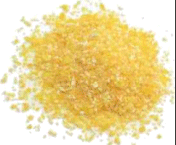 This bright-yellow dish owes it's color to corn and taste to the chef. A staple of northern Italy, polenta is a mush made from cornmeal. It can be eaten hot and creamy, or cooled until firm and then cut into shapes to be baked, fried, or grilled. Once considered a food for the lower, poorer, classes, polenta has become chick and can be found at top restaurants and in the kitchens of Italians.
This bright-yellow dish owes it's color to corn and taste to the chef. A staple of northern Italy, polenta is a mush made from cornmeal. It can be eaten hot and creamy, or cooled until firm and then cut into shapes to be baked, fried, or grilled. Once considered a food for the lower, poorer, classes, polenta has become chick and can be found at top restaurants and in the kitchens of Italians.

